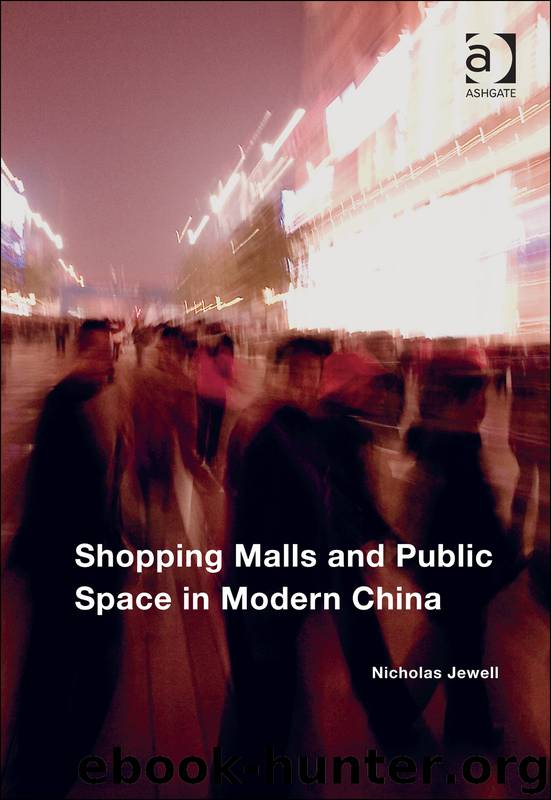Shopping Malls and Public Space in Modern China by Jewell Nicholas

Author:Jewell, Nicholas
Language: eng
Format: epub
Publisher: Taylor & Francis (CAM)
Published: 2015-01-29T16:00:00+00:00
5.6 The below ground mall at IFC Pudong, Shanghai. Image courtesy of Nicholas Jewell.
5.7 A sunken plaza dominated by a totemic Apple symbol forms a consumptive hinge at IFC Pudong, Shanghai. Image courtesy of Nicholas Jewell.
As an anchoring device for the Chinese proto-consumer, this hinge treats the idea of destination – the traditional role of the anchor – as a spectacle. Situated between the two competing malls that occupy this ideological stratum its symbolic focus becomes an apogee of consumption – a point where aspiration and impulse will collide to the ringing of cash registers. In this way it both confirms the importance of the anchor as a device to draw the consumer through the mall’s terrain and seemingly reverses the psychology of the Gruen transfer. Counter-intuition appears to be at work here. But does this modus operandi spell commercial suicide? Will brand hegemony suck the life out of the smaller players that its presence, in earlier manifestations of the mall, was supposed to nurture?
For two reasons this would appear not to be the case. Both are rooted in exploiting the mindset of a rising class consciousness. As ‘a collective dream world of mass culture’50 the mall is a repository for the hopes and fears that shape the group identity of its target demographic. It is fear that first drives this approach. In building a domestic market predicated on homegrown brands China faces a formidable problem. This stems from a legacy of corruption that has blighted the Chinese assembly line processes. At best this has resulted in meticulously faithful simulacra – from imitation products to fully-fledged stores.51 At worst it has resulted in highly dangerous goods finding their onto the open market.52 Accordingly ‘many Chinese trust Western […] brands […] because they believe they would not cut corners in the supply chain process’.53 Placing such a recognizable exponent of Westernized consumption at this entry point harnesses these fears and uses the hypnoidal state induced by its presence to assuage them. As the consumer is forced to percolate through this stage-managed moment, its brand cachet is conflated with the spaces and wares of the mall beyond. It marks out the perceived space of the mall as a realm of otherworldly sophistication and safety. And the marque of homegrown Chinese commodification is naturalized by association. In such a way the mall establishes a group identity focused on the expansion of its domestic market.
Download
This site does not store any files on its server. We only index and link to content provided by other sites. Please contact the content providers to delete copyright contents if any and email us, we'll remove relevant links or contents immediately.
Kathy Andrews Collection by Kathy Andrews(11704)
The remains of the day by Kazuo Ishiguro(8780)
Paper Towns by Green John(5059)
Spare by Prince Harry The Duke of Sussex(5039)
The Body: A Guide for Occupants by Bill Bryson(4934)
Industrial Automation from Scratch: A hands-on guide to using sensors, actuators, PLCs, HMIs, and SCADA to automate industrial processes by Olushola Akande(4895)
Machine Learning at Scale with H2O by Gregory Keys | David Whiting(4069)
Be in a Treehouse by Pete Nelson(3912)
Harry Potter and the Goblet Of Fire by J.K. Rowling(3755)
Never by Ken Follett(3750)
Goodbye Paradise(3700)
Into Thin Air by Jon Krakauer(3286)
The Remains of the Day by Kazuo Ishiguro(3277)
The Cellar by Natasha Preston(3239)
The Genius of Japanese Carpentry by Azby Brown(3207)
Fairy Tale by Stephen King(3185)
120 Days of Sodom by Marquis de Sade(3152)
The Man Who Died Twice by Richard Osman(2977)
Drawing Shortcuts: Developing Quick Drawing Skills Using Today's Technology by Leggitt Jim(2971)
